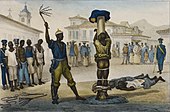Switch (corporal punishment)
This article needs additional citations for verification. (December 2014) |
| Part of a series on |
| Corporal punishment |
|---|
 |
| By place |
| By implementation |
| By country |
| Court cases |
| Politics |
| Campaigns against corporal punishment |
A switch is a flexible rod which is typically used for corporal punishment. Switching is similar to birching.
Punitive switching
[edit]Switches are typically made of strong and flexible wood such as hazel, birch, or hickory.[citation needed] Willow branches are also used, as well as branches from strong trees and large shrubs. Switches are often from a garden or an orchard nearby, or taken from the wild. In the Southeastern United States, fresh-cut, flexible cane (Arundinaria) is commonly used.[citation needed] In the 20th and 21st centuries the use of corporal punishment has been criticized, in both North America and Europe.[1]

Making a switch involves cutting it from the stem and removing twigs or directly attached leaves.[citation needed] For optimal flexibility, it is cut fresh shortly before use, rather than keeping it for re-use over time.[citation needed] Some parents decide to make the cutting of a switch an additional form of punishment for a child, by requiring the disobedient child to cut their own switch.[citation needed]
- The tamarind switch (in Creole English tambran switch) is a judicial birch-like instrument for corporal punishment made from three tamarind rods, braided and oiled, used long after independence in the Caribbean Commonwealth island states of Jamaica and Trinidad and Tobago.[2]
- The Gilbertese tribal community at Wagina in Choiseul province (Solomon Islands) reintroduced by referendum in 2005 traditional "whipping" with coconut tree branches for various offences – the national justice system opposes this.[3]
See also
[edit]- Caning
- Corporal punishment in the home
- Judicial corporal punishment
- School corporal punishment
- Switchgrass
- Switchcane
References
[edit]- ^ Gould, Mark (January 9, 2007). "Sparing the Rod". The Guardian. London. Retrieved February 5, 2009.
- ^ Parker, Quincy (March 7, 2007). "Human Rights Abuse Concerns". The Bahama Journal. Nassau. Retrieved February 5, 2009.
- ^ "Floggings cut crime: village leader". The Sydney Morning Herald. AAP. March 9, 2006. Retrieved February 5, 2009.
